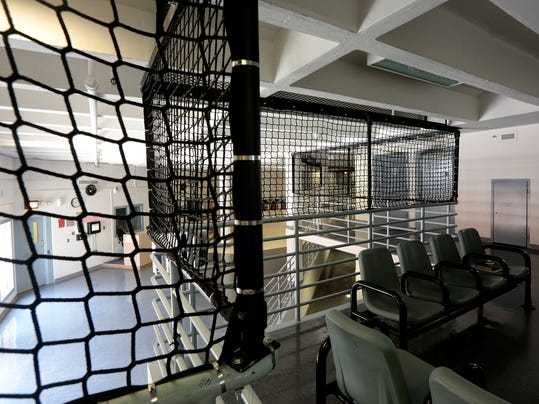Officials Battling Inmate Mental Health Issues

NEWARK – It was about 12:30 a.m. May 31 when a corrections officer at the Licking County Justice Center saw an inmate heading toward the shower area with her sheets.
The inmate was on suicide watch, and the officer intercepted her and asked what she was doing, according to an incident report. The inmate said she was using the sheets to clean up, but the officer instructed her to go back to bed. The inmate complied.
A while later, shortly before 2 a.m., the officer saw the inmate sit up in bed again. This time, the inmate grabbed her sheet, tied it around her neck and started running toward the stairs. The officer jumped up and ran the same direction, colliding with the inmate as she jumped.
The momentum sent the officer tumbling to the bottom of the stairs. The inmate fell further, from the second-tier bunk area to the lower-level floor, but jail officials have said the officer likely saved the inmate from greater harm.
Both survived and were treated at the hospital for minor injuries.
That was one of 11 inmate suicide attempts this year, according to data provided by local jail officials. That includes one death, when inmate Stanton Deeley was found unresponsive in his cell May 13 after tying a sheet around his neck. Five jail employees resigned in late July after an investigation into Deeley’s death found they were not completing their rounds properly.
The sheriff’s office also is facing a $10 million lawsuit in federal court, filed by the family of an inmate who committed suicide in the jail in 2011 by jumping over the railing.
Statewide, inmate suicide seems to be an increasing problem. There have been four suicides at Ohio prisons so far this year, according to the Ohio Department of Rehabilitation and Correction. That’s compared with 10 suicides for all of 2013, eight in 2012 and four in 2011, data show.
At its base, the problem may stem from mental health issues. A 2006 Bureau of Justice Statistics survey found 73 percent of female prisoners in state facilities reported mental health problems, compared with 55 percent of male prisoners. In county jails, 75 percent of female inmates reported mental health problems, compared with 63 percent of male inmates.
Recently, the problem may be compounded by state closures of mental health facilities, said Licking County Sheriff Randy Thorp.
“I can’t solely lay the blame at (the state’s) feet, but I would argue that there is a significant mental health issue right now, as it relates to people having access to adequate diagnosis and care,” Thorp said. “And unfortunately, many of those folks end up in jail.
“I don’t think it’s any secret that most jails — I’d say all jails — are facing a mental health crisis as it relates to the inmates when they’re coming in.”
The justice center has taken steps to curb suicides and attempts. This past year, vertical nets were installed, spanning from second-tier railings in the jail to the ceiling. The railings are about waist-high, and the netting prevents inmates from jumping over the side.
When inmates are booked into the jail, arresting agencies fill out a form that would alert jail staff to any suicidal tenancies they noticed. Inmates undergo mental health evaluations, and the jail also has two full-time mental health workers on staff, “which, for a jail of our size, we’re pretty fortunate to have,” said sheriff’s office Capt. Tom Brown, who leads the jail division.
The jail also is looking into buying an electronic monitoring system that would track officers’ rounds to ensure they are done properly and in a timely manner.
Ultimately, the jail population is a reflection of the community, Brown said: As Newark and Licking County residents struggle with suicide, it only makes sense inmates will, too.
In Licking County, the suicide rate is about 14.7 per 100,000 people, higher than the national average of 11.5 per 100,000 people, according to data from Mental Health America.
“We’re obviously a part of the community,” Brown said, adding that most justice center inmates have local ties.
“We try to do the best we can with what we’re handed. People with mental illnesses and mental problems are absorbing a lot of our resources, because we try to do the best we can to treat them and take care of them the best we can.”
It’s a numbers problem, Brown said. The jail books roughly 4,000 people a year, which means limited individualized attention per inmate.
“Would you like to catch every one of them that has a (mental health) crisis? Absolutely,” he said. “Is it 100 percent going to keep suicide attempts from happening in the jail? I don’t think that’s even a possibility.”
You can share your opinion about this situation at Art and Interior.
This Article appeared in the Newark Advocate August 3, 2014
